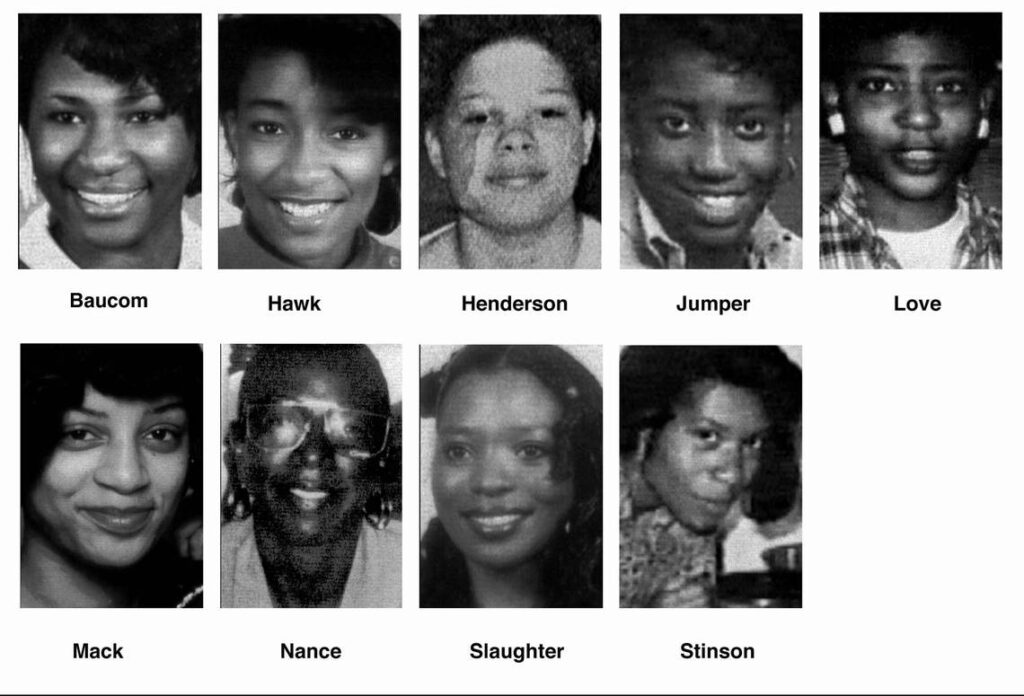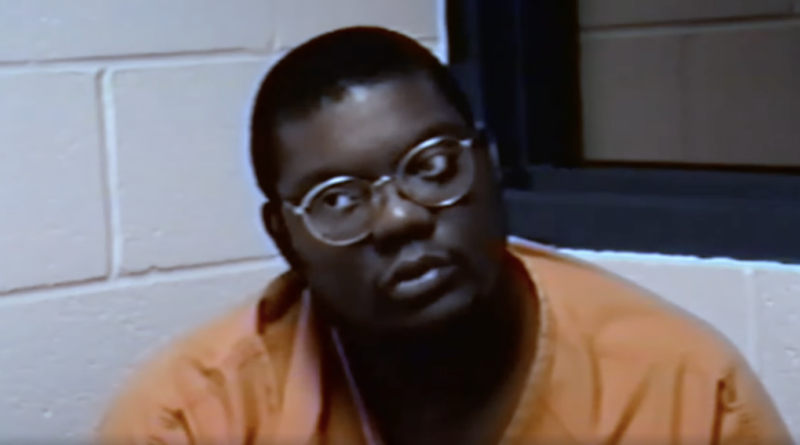Henry Louis Wallace “The Taco Bell Strangler” in Charlotte North Carolina
Henry Louis Wallace, also known as “The Taco Bell Strangler,” stands as one of the most notorious serial killers in the history of the United States. His reign of terror in the 1990s left Charlotte, North Carolina, reeling with fear as he targeted young, vulnerable women. Despite a troubled upbringing, no one could have predicted the horrific crimes Wallace would eventually commit. Over a period of several years, he murdered at least 11 women, most of whom he knew personally, leaving a trail of devastation in his wake.
This article delves into the chilling life of Henry Louis Wallace, from his early years to his capture and conviction, shedding light on the motivations behind his killing spree and the police investigation that finally brought him to justice.
Early Life of Henry Louis Wallace
Born on November 4, 1965, in Barnwell, South Carolina, Henry Louis Wallace had a tumultuous childhood marked by instability and emotional trauma. His father abandoned the family before his birth, leaving his mother, Lottie Mae Wallace, to raise him and his older sister alone. Lottie Mae was a strict and sometimes abusive disciplinarian who worked long hours as a textile worker to support her children.
Wallace’s upbringing was fraught with challenges, from his mother’s harsh parenting style to the poverty that surrounded them. He attended Barnwell High School, where he was an unremarkable student, though he did show interest in extracurricular activities like the marching band. After graduating in 1983, he briefly attended a local technical college but dropped out to enlist in the U.S. Navy in 1985. His time in the Navy provided him some structure, but Wallace’s life began to unravel soon after his discharge.
Psychological Profile and Early Signs of Trouble
While Henry Louis Wallace’s childhood had been difficult, there were no glaring signs that he would become a serial killer. However, experts who later evaluated him noted a combination of factors that might have contributed to his descent into criminality. His troubled upbringing, combined with substance abuse issues and unresolved feelings of anger and inadequacy, created a volatile psychological state.
Throughout his adolescence and early adulthood, Wallace struggled to maintain steady relationships, both professionally and personally. He held various low-paying jobs, including positions at fast-food restaurants like Taco Bell, where he would later meet several of his victims. Wallace also developed a drug habit that further destabilized his already fragile mental health.
Despite his struggles, Wallace managed to maintain an outward appearance of normalcy, avoiding attention from law enforcement and those around him. This ability to blend into his community would become a key factor in the delay of his capture.
The Beginning of the Murders
Henry Louis Wallace’s killing spree began in 1990, with his first known victim being Tashanda Bethea, a woman he had dated briefly. He strangled her and dumped her body in a lake. Although Wallace was questioned by police, there wasn’t enough evidence to link him to the crime, and he was allowed to walk free.
In 1992, Wallace moved to Charlotte, North Carolina, where he took a job at Taco Bell. Over the next two years, he would go on to murder 11 women, all of whom he knew personally. His victims were primarily young Black women, many of whom were friends, coworkers, or acquaintances. Wallace’s familiarity with his victims allowed him to gain their trust, making it easier for him to lure them into dangerous situations.
The Modus Operandi: How Wallace Targeted His Victims
Wallace’s method of operation was as chilling as it was effective. He used his familiarity with his victims to disarm them, often visiting them in their homes or apartments. Many of the women lived in the same neighborhood, and some even worked with Wallace at Taco Bell. His ability to blend into their lives made him seem non-threatening, which allowed him to strike without raising suspicion.
Once he gained access to their homes, Wallace would strangle his victims, often sexually assaulting them before or after their deaths. He would then ransack their homes, stealing items of value to either sell or pawn to fuel his drug habit. The brutality of his crimes was staggering, yet for a long time, his actions went unnoticed by authorities, in part due to a lack of communication between police departments and systemic failings in how missing person cases were handled.
Under the Radar
Henry Louis Wallace worked at multiple fast food restaurants, including at least two Taco Bell locations in Charlotte, North Carolina. These restaurants became central to his activities, as several of his victims were either coworkers or women he met through connections at these workplaces. His job at Taco Bell allowed him to blend into the community and maintain an outward appearance of normalcy while secretly committing his brutal crimes. Wallace’s familiarity with his victims—many of whom worked with him or knew him socially—made it easier for him to gain their trust, which facilitated his ability to target and murder them without raising immediate suspicion.
Henry Louis Wallace Victims

Tashanda Bethea
Tashanda Bethea, often regarded as Henry Louis Wallace’s first known victim, met him in 1990 while they were still living in his hometown of Barnwell, South Carolina. Bethea and Wallace had briefly dated, and although their relationship did not last long, Wallace was able to gain her trust. On March 8, 1990, Wallace lured Bethea into his car under the pretense of giving her a ride. As the two drove around, an argument ensued, leading Wallace to snap. In a sudden outburst of violence, Wallace attacked Bethea, strangling her to death.
After killing her, Wallace showed no immediate remorse and coldly disposed of her body. He dumped her remains in a lake, leaving her to sink to the bottom. Bethea’s body was later found, but there was not enough evidence to connect Wallace to the murder at the time. This marked the beginning of Wallace’s descent into serial killing, and his ability to blend into his surroundings and avoid suspicion would enable him to continue his spree for years.
Sharon Nance
Sharon Nance was a 33-year-old sex worker and convicted drug dealer, whom Henry Louis Wallace encountered in Charlotte, North Carolina, in May 1992. Unlike many of his later victims, Nance was not someone Wallace knew personally, but rather a casual acquaintance he came across in the streets. On the night of her murder, Wallace had solicited Nance’s services but failed to pay her, leading to an argument. In a fit of rage, Wallace brutally attacked her, beating her before ultimately deciding to end her life by bludgeoning her to death with a rock.
After killing her, Wallace did not make any effort to hide her body, leaving it abandoned in a secluded area. Nance’s body was discovered a few days later, but due to her lifestyle and the transient nature of her work, the case received little attention. Her murder remained unsolved for several years until Wallace’s eventual confession linked him to her death.
Caroline Love
Caroline Love, a 20-year-old Charlotte resident, was one of the closest victims to Henry Louis Wallace, both geographically and personally. Love was not only Wallace’s girlfriend’s roommate, but she also worked at the same Taco Bell restaurant where Wallace was employed. Wallace had known Love for some time before he decided to target her. On June 15, 1992, Wallace visited Love’s apartment under the guise of a friendly visit. As someone she trusted, Love had no reason to fear him when he came by.
Once inside the apartment, Wallace suddenly turned violent. He overpowered Love, strangling her with his hands before sexually assaulting her. After she died, Wallace wrapped her body in bed linens and took it with him. He later dumped her remains in a wooded area in Charlotte, where her body would go undiscovered for weeks. Initially reported as a missing person, Love’s disappearance confused her family and friends, none of whom suspected Wallace. It wasn’t until his eventual confession that her fate became clear, and her body was found in a state of advanced decomposition.
Shawna Denise Hawk
Shawna Denise Hawk was a 20-year-old student at Central Piedmont Community College in Charlotte, North Carolina. She was also an assistant manager at Taco Bell, where she worked directly with Henry Louis Wallace. Hawk was known for her bright personality and strong work ethic, and she developed a friendly rapport with Wallace, who often played the role of a supportive coworker. However, Wallace harbored sinister intentions toward her. On February 19, 1993, he visited her home, where they engaged in casual conversation before Wallace suddenly attacked her.
Wallace strangled Hawk in her own bathroom, using his bare hands to squeeze the life out of her. After killing her, Wallace placed her body in the bathtub, where he left her partially submerged, hoping it would delay decomposition and complicate the forensic investigation. He also took time to ransack her apartment, stealing small items of value, such as jewelry and cash, which he later pawned to feed his drug habit. Hawk’s body was discovered by her mother, who had grown concerned after not hearing from her daughter. Hawk’s murder shook the community, but the connection between her and Wallace remained unnoticed until his later confessions.
Audrey Spain
Audrey Spain, another young woman who worked with Henry Louis Wallace at Taco Bell, was just 24 years old when she became one of his victims. Spain, like many of Wallace’s other victims, had no reason to distrust him. On June 22, 1993, Wallace visited her at her apartment under friendly pretenses, a scenario that had played out with chilling familiarity in previous murders. Once inside, Wallace attacked Spain with calculated brutality. He strangled her with his hands before sexually assaulting her, making her one of several victims to endure this horrific violation.
After Spain died, Wallace followed his usual pattern of looting the victim’s apartment, taking whatever he could find that might fetch a small price. He left her body in her apartment, where it was discovered by a friend after she failed to show up for work. Spain’s murder deepened the sense of fear in Charlotte, but authorities still did not link her death to Wallace, even though her connection to him seemed evident in hindsight.
Valencia M. Jumper
Valencia M. Jumper was one of the many young women whose lives were tragically cut short by Henry Louis Wallace. Jumper, a 21-year-old college student at Johnson C. Smith University, had ambitions and a promising future ahead of her. She and Wallace were friends, sharing social ties through Wallace’s sister, who was close to Jumper. This relationship made it easy for Wallace to gain her trust, as she had no reason to fear him when he came to her apartment.
On August 10, 1993, Wallace visited Jumper at her Charlotte apartment under the guise of a friendly visit. What started as a casual encounter quickly turned into a nightmare. Wallace, always calculating, decided to strangle her, using his hands to choke the life out of her. After killing Jumper, Wallace, in a disturbing effort to cover up his crime, decided to set her body and apartment on fire. His goal was to stage the murder as an accidental death caused by a fire, hoping to mislead investigators and prevent any suspicion from falling on him.
The fire consumed much of the evidence, but not enough to conceal the truth. Jumper’s charred remains were found, and her death was initially thought to be accidental. For a time, Wallace’s deception worked, and authorities believed that the fire had been caused by a faulty appliance, completely unaware that her death had been the result of a brutal murder. However, when Wallace was finally apprehended and confessed to his string of murders, the true nature of Jumper’s death was revealed.
Wallace admitted to strangling Jumper and setting the fire as a way to destroy evidence and cover his tracks. Valencia Jumper’s family and friends were devastated by the revelation, particularly because Wallace had been someone they knew and trusted. Her death, like the others, left a profound impact on the Charlotte community, and it underscored the way Wallace used his personal connections to carry out his horrific crimes while evading detection for so long.
Michelle Stinson
On September 15, 1993, Wallace visited his friend and Taco Bell co-worker, Michelle Stinson’s apartment in Charlotte, under the guise of a casual social call. Trusting him as a friend, she let him inside, unaware of the danger that awaited her. Once inside, Wallace turned violent. In a horrifying escalation, he attacked Stinson, overpowering her and then strangling her to death. Unlike some of his other victims, Wallace used both strangulation and stabbing to kill Stinson. After choking her, he stabbed her multiple times in the chest to ensure she was dead.
The murder was particularly cruel because Stinson’s two children were present in the apartment at the time. After killing her, Wallace left the scene, abandoning her body for the children to eventually find. It wasn’t long before Stinson’s body was discovered by friends and neighbors, who, horrified, found her lifeless in the apartment with her children unharmed but left behind.
Stinson’s murder, like many others in Wallace’s killing spree, was initially not linked to the growing number of strangulation deaths in Charlotte. Police treated her case as an isolated incident, despite the clear signs of a brutal and premeditated crime. Wallace’s ability to blend into his surroundings and maintain relationships with his victims enabled him to continue killing without raising suspicion.
Vanessa Little Mack
Vanessa Mack, a 25-year-old single mother, became another tragic victim of Henry Louis Wallace’s murderous rampage. Like many of the other women he killed, Mack knew Wallace personally through his girlfriend. On February 20, 1994, Wallace visited her apartment under the pretense of socializing, but he had much darker intentions in mind. Once inside, Wallace overpowered Mack and strangled her to death. He then sexually assaulted her lifeless body and ransacked her home, looking for anything of value.
Mack’s body was left in her apartment, where it was later found by her family. Her murder, like those before it, caused tremendous grief to those who knew her, but Wallace’s connection to the crime went undetected. The discovery of yet another strangled woman only deepened the growing fear in the community, though the police still hadn’t pieced together the pattern that linked these killings to a single perpetrator.
Brandi June Henderson
Brandi Henderson, 18, was a young mother living in Charlotte. She, too, had some social ties to Wallace, which allowed him easy access to her home. On March 9, 1994, Wallace visited her apartment while she was at home with her infant son. In a tragic turn of events, Wallace strangled Henderson to death, even while her baby was nearby. After killing her, he assaulted her and left her body lying in her apartment. In a particularly chilling detail, Wallace also attempted to strangle Henderson’s baby but, fortunately, the child survived the attack.
Henderson’s murder, occurring so soon after Baucom’s, sent shockwaves through the community. It was only after Wallace’s arrest that his connection to her death, along with the others, became apparent.
Betty Jean Baucom
Betty Jean Baucom, a 24-year-old woman living in Charlotte, was another close acquaintance of Wallace’s. On March 8, 1994, Wallace entered Baucom’s apartment under familiar circumstances. Like his other victims, Baucom had no reason to fear Wallace. He strangled her with ruthless efficiency and then proceeded to sexually assault her post-mortem. After her death, Wallace rummaged through her apartment, stealing valuables and cash before fleeing the scene.
It was Baucom’s murder that would ultimately lead to Wallace’s downfall. The increasing pressure on law enforcement to solve the string of murders, combined with forensic evidence linking Wallace to the crime, finally led to his arrest just days later. Wallace confessed to Baucom’s murder, along with the others, bringing his reign of terror to an end.
Debra Slaughter
Debra Slaughter, another acquaintance of Henry Louis Wallace, was the final victim in his deadly spree. On March 11, 1994, just two days before his arrest, Wallace entered Slaughter’s home. As with his other victims, he strangled Slaughter and sexually assaulted her post-mortem. After killing her, Wallace ransacked her apartment, looking for money or items he could pawn. Unlike some of his earlier murders, Slaughter’s killing occurred at a time when law enforcement was beginning to close in on Wallace.
Her murder marked the end of his brutal reign of terror. Just a day later, on March 13, 1994, Wallace was apprehended by police. His capture brought an end to the string of murders that had terrorized Charlotte for years, though the impact of his crimes continues to haunt the families of his victims.
The Arrest and Confession
Henry Louis Wallace was finally arrested on March 13, 1994, following the murder of his last victim, Debra Slaughter. In the days following his arrest, Wallace confessed to the murders of 11 women. His confessions were chilling in their detail, as he recounted how he gained the trust of his victims before brutally attacking them. Wallace also expressed regret for his crimes, but many questioned the sincerity of his remorse.
Wallace’s arrest sent shockwaves through Charlotte, particularly within the communities where his victims had lived and worked. For years, people had unknowingly interacted with a serial killer, a man who had managed to conceal his dark side while living among them.
The Failure of Law Enforcement
One of the most shocking aspects of Henry Louis Wallace’s case was the failure of law enforcement to connect the murders sooner. Despite the similarities between the victims—many of whom worked in the same Taco Bell establishment or had social connections—police were slow to link the cases.
A major factor in this delay was the socio-economic background of the victims. All of the women were Black, and most came from working-class backgrounds. At the time, there was significant criticism of how the Charlotte-Mecklenburg Police Department handled cases involving minority women, with many arguing that the cases were not given the same attention as those involving white victims. The growing number of unsolved murders created a climate of fear, particularly in the Black community, but it would take years before law enforcement realized they were dealing with a serial killer.
The Trial and Sentencing
Wallace’s trial began in September 1996 and attracted significant media attention. During the trial, prosecutors laid out the gruesome details of Wallace’s murders, while his defense attempted to argue that his troubled upbringing and mental health issues should be considered as mitigating factors. The jury, however, was unmoved by these arguments.
On January 29, 1997, Henry Louis Wallace was convicted of nine counts of murder and sentenced to death. He is currently on death row at Central Prison in Raleigh, North Carolina, where he awaits execution. Despite numerous appeals over the years, his death sentence remains in place.
Impact on the Victims’ Families and the Community
The impact of Henry Louis Wallace’s crimes on the victims’ families and the Charlotte community was profound. The families of the women he murdered have expressed frustration and anger at how long it took for law enforcement to capture Wallace. Many of them believe that if the police had acted more swiftly and effectively, some of the murders could have been prevented.
In the years following Wallace’s arrest, there has been increased awareness and discussion about how law enforcement handles cases involving minority women. The case served as a wake-up call for police departments nationwide, highlighting the need for better communication between jurisdictions and more attention to cases involving vulnerable communities.
The Legacy of The Taco Bell Strangler
Henry Louis Wallace’s reign of terror left an indelible mark on Charlotte and the families of his victims. His ability to evade capture for so long, despite the clear pattern of his crimes, raised serious questions about the justice system’s ability to protect marginalized communities. In the years since his capture, there have been numerous documentaries and true crime specials dedicated to his case, ensuring that his name, and the memory of his victims, are not forgotten.
Despite his attempts to appeal his conviction, Wallace remains on death row, a grim reminder of the horrors he inflicted. His case continues to be studied by criminologists and psychologists, offering insights into the mind of a serial killer and the systemic failures that allowed him to operate undetected for so long.
Discover more from City Towner
Subscribe to get the latest posts sent to your email.




